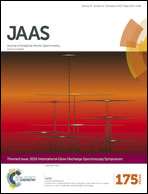Compressed sensing spectral imaging for plasma optical emission spectroscopy
Abstract
Plasma optical emission spectral imaging is critical for the development of chemical analysis applications and plasma diagnostics. Nevertheless, typical techniques require array detectors that can be very expensive or pixel-to-pixel rastering approaches that are highly time-consuming. Further, the acquired image files are compressed to keep data manageable, which can be achieved without loss of critical information, thus showing the sparsity of the data. A fairly recent paradigm in sampling, compressed sensing (CS), allows performing compression during acquisition which results in a more efficient use of experimental resources. As such, CS systems can be much faster, cost-effective, or even provide better resolution or throughput. In this study, a CS spectral imaging system, featuring a single-sensor and a variable encoding mask, is designed and implemented for plasma optical emission spectroscopy. The performance, based on PSNR and spatial resolution, is characterized as a function of experimental and image processing parameters such as sensing matrix selection, recovery algorithm choice, and sparsifying basis. Spectral images of optical emissions from plasma species of interest (He I, N2, N2+) were collected from an atmospheric pressure plasma jet. The use of a CS spectral imaging system for plasma diagnostics (Tvib) is reported for the first time.

- This article is part of the themed collections: JAAS Emerging Investigator Lectureship winners and Glow Discharge Spectroscopy

 Please wait while we load your content...
Please wait while we load your content...